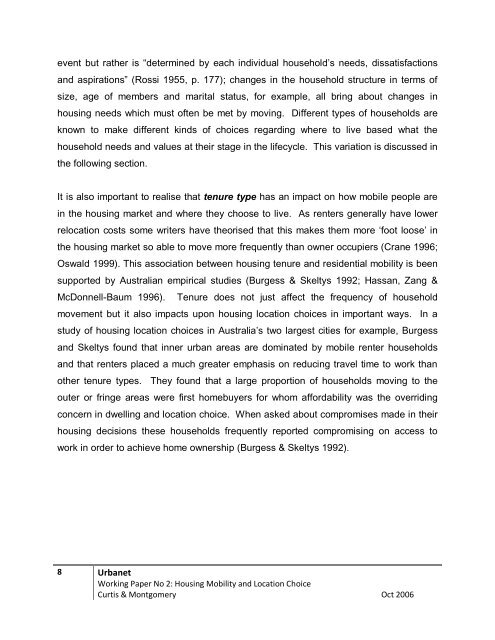Housing Mobility and Location Choice - Urbanet - Curtin University
Housing Mobility and Location Choice - Urbanet - Curtin University
Housing Mobility and Location Choice - Urbanet - Curtin University
Create successful ePaper yourself
Turn your PDF publications into a flip-book with our unique Google optimized e-Paper software.
event but rather is “determined by each individual household’s needs, dissatisfactions<br />
<strong>and</strong> aspirations” (Rossi 1955, p. 177); changes in the household structure in terms of<br />
size, age of members <strong>and</strong> marital status, for example, all bring about changes in<br />
housing needs which must often be met by moving. Different types of households are<br />
known to make different kinds of choices regarding where to live based what the<br />
household needs <strong>and</strong> values at their stage in the lifecycle. This variation is discussed in<br />
the following section.<br />
It is also important to realise that tenure type has an impact on how mobile people are<br />
in the housing market <strong>and</strong> where they choose to live. As renters generally have lower<br />
relocation costs some writers have theorised that this makes them more ‘foot loose’ in<br />
the housing market so able to move more frequently than owner occupiers (Crane 1996;<br />
Oswald 1999). This association between housing tenure <strong>and</strong> residential mobility is been<br />
supported by Australian empirical studies (Burgess & Skeltys 1992; Hassan, Zang &<br />
McDonnell-Baum 1996). Tenure does not just affect the frequency of household<br />
movement but it also impacts upon housing location choices in important ways. In a<br />
study of housing location choices in Australia’s two largest cities for example, Burgess<br />
<strong>and</strong> Skeltys found that inner urban areas are dominated by mobile renter households<br />
<strong>and</strong> that renters placed a much greater emphasis on reducing travel time to work than<br />
other tenure types. They found that a large proportion of households moving to the<br />
outer or fringe areas were first homebuyers for whom affordability was the overriding<br />
concern in dwelling <strong>and</strong> location choice. When asked about compromises made in their<br />
housing decisions these households frequently reported compromising on access to<br />
work in order to achieve home ownership (Burgess & Skeltys 1992).<br />
8 <strong>Urbanet</strong><br />
Working Paper No 2: <strong>Housing</strong> <strong>Mobility</strong> <strong>and</strong> <strong>Location</strong> <strong>Choice</strong><br />
Curtis & Montgomery Oct 2006


